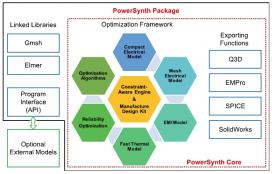PowerSynth Improvements Help Design Power Modules to Meet Space and Cost Constraints
Researchers have improved the PowerSynth software tool in work supported by the Center for Power Optimization of Electro-Thermal Systems (POETS), an NSF-funded Engineering Research Center (ERC) based at the University of Illinois. PowerSynth eases the design of power modules, with an emphasis on reliability and signal integrity.
PowerSynth has simplified the tedious process of designing power modules. Improvements to the software help to integrate related components into power modules, saving space and money, as well as enabling 3D layouts with multiple substrates—among other benefits to an electronics industry facing compact layouts and tighter cost and design constraints. Using PowerSynth, the design flow from the beginning to the end is 5 to 10 times faster than the traditional flow, which generally takes weeks.
In the past, engineers have spent days and weeks on designing power modules through trial-and-error methods. PowerSynth is a software tool designed to allow engineers with little packaging expertise to create power module layouts for electronics from a draft design. It can be used to prototype layouts without the need for highly experienced experts in power-module design.
The recent improvements build on the first version of PowerSynth, which enabled layouts of limited complexity that improved on hand-generated designs. PowerSynth research has focused on addressing some of the limitations cited by developers and end-users. The acceleration in design time comes from four contributors: First is the time savings per design iteration. Second is the reduction of the number of hand design iterations. Third is the guarantee of optimality in design tradeoffs. Fourth is the design insight with a visualization of the nature and magnitude of the design tradeoffs themselves.



